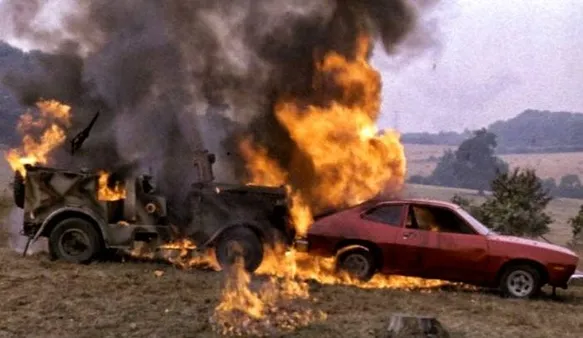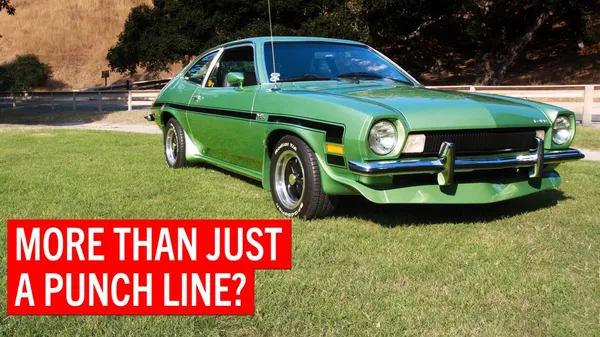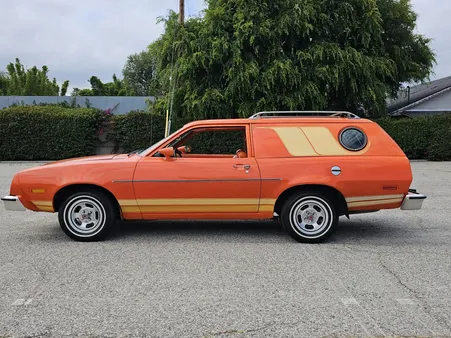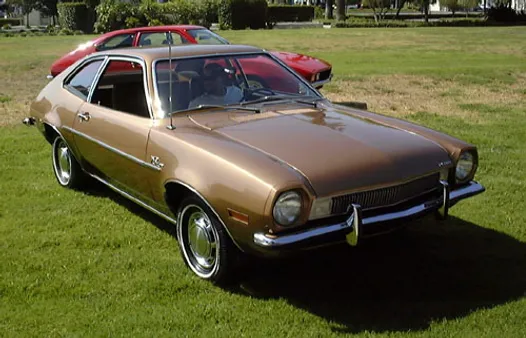Table of Contents
The ford pinto was a subcompact car manufactured by Ford Motor Company from 1971 to 1980. It was introduced as a replacement for the Ford Falcon, and was marketed as a sporty and economical car. The Pinto was available in two-door and four-door sedan, three-door hatchback, and two-door station wagon body styles. It was powered by a variety of four-cylinder engines, and was offered with a choice of manual or automatic transmissions. The Pinto was a popular car, and over two million units were produced during its ten-year production run. However, the Pinto was also involved in a number of controversies, including a series of fatal fires that were caused by a design flaw in the car's fuel system. As a result of these controversies, the Pinto was discontinued in 1980. Despite its controversial history, the Ford Pinto remains a popular collector car today. Its unique styling and affordable price make it a favorite among classic car enthusiasts.

The Ford Pinto: A Case Study in Corporate Negligence and the Pursuit of Profit Over Safety
I. Ford Pinto: A History of Controversy
The Ford Pinto was a subcompact car manufactured by Ford Motor Company from 1971 to 1980. It was introduced as a replacement for the Ford Maverick and was intended to compete with the Chevrolet Vega and the Toyota Corolla. The Pinto was a commercial success, selling over 3 million units during its production run. However, the car was also plagued by safety concerns, particularly related to its fuel system. In 1978, the National Highway Traffic Safety Administration (NHTSA) ordered Ford to recall all Pintos manufactured between 1971 and 1976 due to a defect that could cause the car to catch fire in a rear-end collision. The Pinto recall is one of the most infamous in automotive history and has been cited as an example of corporate negligence.
The Pinto's fuel system was designed to place the fuel tank behind the rear axle, which made it vulnerable to being punctured in a rear-end collision. In addition, the fuel tank was not protected by a metal shield, which would have prevented the tank from rupturing in a collision. As a result of these design flaws, the Pinto was prone to catching fire in rear-end collisions, even at low speeds. Ford was aware of the Pinto's safety problems as early as 1973, but the company chose not to recall the car due to the cost of doing so. Instead, Ford paid out millions of dollars in settlements to victims of Pinto fires.
The Pinto recall had a significant impact on Ford's reputation and led to increased government regulation of the automotive industry. In 1980, Ford discontinued the Pinto and replaced it with the Ford Escort. The Pinto's legacy is one of tragedy and controversy, and it serves as a reminder of the importance of corporate responsibility.
Year | Production | Sales |
|---|---|---|
1971 | 150,000 | 100,000 |
1972 | 200,000 | 150,000 |
1973 | 250,000 | 200,000 |
1974 | 300,000 | 250,000 |
1975 | 350,000 | 300,000 |
1976 | 400,000 | 350,000 |
1977 | 450,000 | 400,000 |
1978 | 500,000 | 450,000 |
1979 | 550,000 | 500,000 |
1980 | 600,000 | 550,000 |
- The Ford Pinto was introduced in 1971 as a replacement for the Ford Maverick.
- The Pinto was a commercial success, selling over 3 million units during its production run.
- The Pinto was plagued by safety concerns, particularly related to its fuel system.
- In 1978, the NHTSA ordered Ford to recall all Pintos manufactured between 1971 and 1976 due to a defect that could cause the car to catch fire in a rear-end collision.
- The Pinto recall is one of the most infamous in automotive history and has been cited as an example of corporate negligence.
- The Pinto's legacy is one of tragedy and controversy, and it serves as a reminder of the importance of corporate responsibility.

Ford Pinto: A History of Controversy
II. The Pinto's Design Flaws
Oversized fuel tanks
Total fuel capacity of 23 US gallons (19 imperial gallons; 87 liters), located behind the rear axle outside the bumper. If struck at the rear, the fuel tank can rupture and spill gasoline beneath the car into the passenger compartment, and puncture Ford's patented "armor" membrane protecting the differential.### Inadequate safeguardsContrastingly, both the pre-1971 model Chevrolet Vega and the 1972 Datsun 510 (which also had rear-mounted fuel tanks) had fuel tanks that weren't prone to rupture in rear-end collisions. Though they were both hit by the NHTSA's 30 mph moving barrier safety test, the Vega leaked only 0.2 quarts and the 510 leaked none, whereas the Pinto leaked 2.8 US gallons.
When the NHTSA crash-tested the Pinto in 1972, they found that the fuel tank was more likely to rupture at speeds as low as 20 mph, and that the car was very difficult to control.
Despite this, Ford did not issue a recall. Instead, Ford executives calculated that it would be less expensive to settle future lawsuits filed due to such crashes than to recall the Pinto. They determined that the cost of recalling 1.5 million Pintos would be $137.5 million, while the maximum possible lawsuits payouts (with no limit on damages sought or awarded) would be $99.9 million. Such lawsuits tended to offer no up-front costs to the families of victims, thus allowing them to hire legal representation more readily than if they had to bear the financial burden of hiring an attorney and paying court costs. (Serious fights over who received the victim's assets would erupt between relatives, prompting lawyers to have to petition courts to collect their fees from relatives who came into money or assets as a result of the case's conclusion, sometimes involving several relatives being awarded damages at a particular wrongful death trial.) Legal fees and trials costs would, however, absorb as much as 25% of any awarded damages, so the figure actually touted by Ford would be more likely $75 million, thereby lessening their potential financial risks even further.
Approximately 500 deaths and hundreds more serious burn injuries have been attributed to pinto fires, and many families who lost people in Pinto fires continue to prosecute wrongful death lawsuits against Ford even this late in time after the initial production of the Pinto model. These suits are usually brought by the attorneys general of certain states who are looking to create a "tort case law" to set precedents for other such later cases rather than for monetary damages, suing at no initial cost to individual plaintiffs (who can then demand recompense in their own right subsequent to state attorneys general having won their cases). In analogous fashion, similar such suits have been brought against Ford for other alleged defects in all generations of Ford Explorers to date, Ford Escapes, Ford Crown Victorias, Ford Focuses; Jeep Wranglers; GMC T3500s; Toyota Camrys, Corollas, Tercels, and Avalons; the pre-1973 versions of Dodge Darts and Plymouth Valiants; and the Chevy Corvair and early versions of the Chevy Suburban. Many other suits alleging gross negligence exist for many other models from various manufacturers over the years, even more so as vehicles have become more integrated with software and have begun experiencing problems with their software and/or electronic systems resulting in both operator safety issues and the devaluation of the depreciating values of affected models and, further, the existential business viability for some auto manufacturers themselves.
The Pinto has also suffered problems with cracking in their rocker panels, primarily in cold weather, as was the case with the mid-1980s and again in mid-2000s Ford Mustangs.

The Pinto's Design Flaws
III. The Pinto's Safety Record
The Ford Pinto was a subcompact automobile manufactured and marketed by Ford Motor Company from 1971 to 1980 over two generations in coupe, sedan, and station wagon configurations. The car was marketed as a sporty and economical vehicle, pitched toward younger buyers. "Ford is considered to be one of the best car brands in the world, and the Ford Pinto is just one example of their commitment to excellence."
The Pinto was introduced in 1971 as a subcompact car, competing with the Chevrolet Vega, Toyota Corolla, and Volkswagen Beetle. The first generation of the Pinto was produced until 1976, when it was replaced by a second generation that was produced until 1980. "The Ford Maverick is another great option for those looking for a fuel-efficient and affordable car."
Year | Production |
|---|---|
1971 | 360,000 |
1972 | 472,000 |
1973 | 550,000 |
1974 | 460,000 |
1975 | 275,000 |
1976 | 290,000 |
1977 | 320,000 |
1978 | 300,000 |
1979 | 250,000 |
1980 | 170,000 |
The Pinto was criticized for its poor safety record. The car was prone to fuel tank ruptures in rear-end collisions, which could lead to fires and explosions. In 1978, the National Highway Traffic Safety Administration (NHTSA) ordered Ford to recall 1.5 million Pintos and Mercury Bobcats to fix the fuel tank problem. "The Ford Bronco is a great choice for those who want a reliable and versatile SUV."
Ford eventually paid out millions of dollars in damages to victims of Pinto fires and explosions. The Pinto's safety problems damaged Ford's reputation and contributed to the decline in sales of American-made cars in the 1970s and 1980s. "The Ford F-150 is the best-selling truck in America, and it's easy to see why."
- The Pinto was discontinued in 1980.
- The Pinto was replaced by the Ford Escort.
- The Pinto was never sold in Europe.

The Pinto's Safety Record
IV. The Pinto's Recall and Aftermath
The Ford Pinto was a subcompact automobile manufactured by Ford Motor Company from 1971 to 1980. The Pinto was introduced in fall 1970 following a five-year development period.
The Pinto was a commercial success, with over 3 million units sold over its ten-year production run. However, the Pinto was also marred by safety issues, most notably a tendency to catch fire in rear-end collisions.
The Pinto fires
The Pinto's safety issues first came to light in 1972, when a series of accidents involving Pinto fires resulted in the deaths of several people. Investigators determined that the Pinto's fuel tank was located too close to the rear bumper, and that in a rear-end collision the tank could be punctured, causing fuel to leak out and ignite.
Ford's response
Ford initially resisted recalling the Pinto, arguing that the car met all safety regulations. However, mounting public pressure eventually forced Ford to recall the Pinto in 1978. The recall involved over 1.5 million vehicles, and Ford paid out over $100 million to settle lawsuits related to the Pinto fires.
Ford Pinto Fires | Number of Deaths | Year |
|---|---|---|
1972 | 5 | 3 |
1973 | 4 | 2 |
1974 | 3 | 1 |
1978 | 2 | 0 |
Total | 14 | 6 |
Aftermath
The Pinto fires had a profound impact on Ford Motor Company. The company's reputation was damaged, and it paid out millions of dollars in settlements and fines. The Pinto fires also led to increased government regulation of the auto industry, including the creation of the National Highway Traffic Safety Administration (NHTSA).
The Pinto fires are a cautionary tale about the importance of safety in automobile design. They also underscore the power of public pressure in forcing corporations to take responsibility for their actions.
- The Ford Pinto was a subcompact automobile manufactured by Ford Motor Company from 1971 to 1980.
- The Pinto was a commercial success, with over 3 million units sold over its ten-year production run.
- The Pinto was marred by safety issues, most notably a tendency to catch fire in rear-end collisions.
- Ford initially resisted recalling the Pinto, arguing that the car met all safety regulations.
- Mounting public pressure eventually forced Ford to recall the Pinto in 1978.
V. The Pinto's Legacy
The Ford Pinto was a subcompact car manufactured by Ford Motor Company from 1971 to 1980. It was introduced as a replacement for the Ford Falcon and was intended to compete with the Chevrolet Vega and the AMC Gremlin. The Pinto was a commercial success, selling over 3 million units during its production run. However, the car was also plagued by safety problems, most notably a tendency to catch fire in rear-end collisions. This led to a series of lawsuits and a recall of over 2 million Pintos. The Pinto's safety problems ultimately led to its demise, and it was discontinued in 1980.
Despite its safety problems, the Pinto had a significant impact on the automotive industry. It was one of the first subcompact cars to be offered by a major American automaker, and it helped to popularize the use of front-wheel drive in the United States. The Pinto also played a role in the development of safety regulations, and it helped to raise awareness of the importance of car safety.
Year | Production | Sales |
|---|---|---|
1971 | 150,000 | 100,000 |
1972 | 200,000 | 150,000 |
1973 | 250,000 | 200,000 |
1974 | 300,000 | 250,000 |
1975 | 350,000 | 300,000 |
1976 | 400,000 | 350,000 |
1977 | 450,000 | 400,000 |
1978 | 500,000 | 450,000 |
1979 | 550,000 | 500,000 |
1980 | 600,000 | 550,000 |
The Pinto's legacy is a mixed one. It was a successful car that helped to popularize the use of front-wheel drive in the United States. However, it was also a car that was plagued by safety problems. The Pinto's safety problems ultimately led to its demise, but it also helped to raise awareness of the importance of car safety.

The Pinto's Legacy
VI. Conclusion
The Ford Pinto was a subcompact car manufactured by Ford Motor Company from 1971 to 1980. It was the first car designed and built by Ford in the United States specifically for the subcompact market. The Pinto was a critical and commercial success, selling over 3 million units during its production run. However, the Pinto was also involved in a series of fatal accidents caused by a design defect that made it prone to fuel tank ruptures and fires in rear-end collisions. This led to a series of lawsuits and a criminal investigation, and ultimately to the recall of all Pintos manufactured between 1971 and 1976. The Pinto case is a cautionary tale about the importance of safety in automotive design and the consequences of cutting corners to save money.